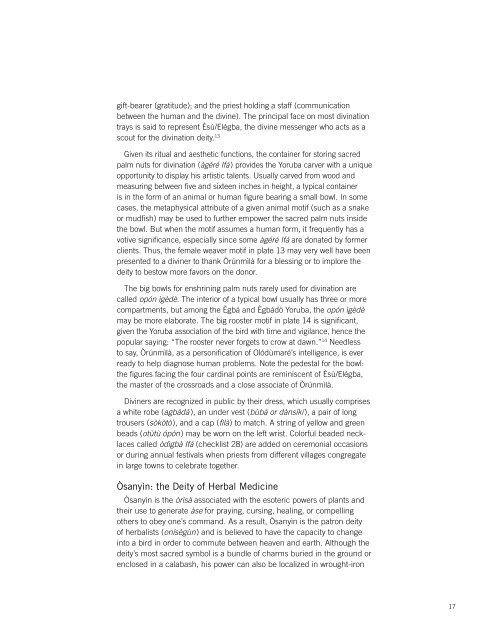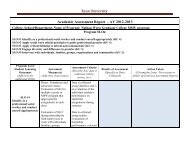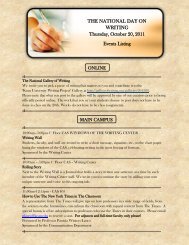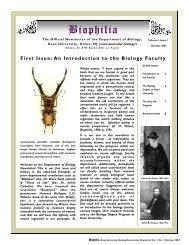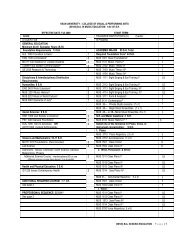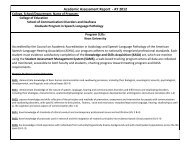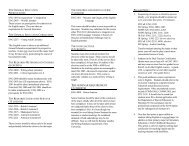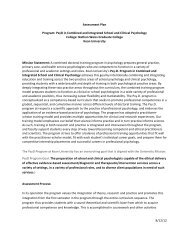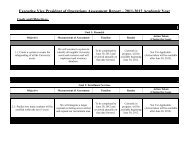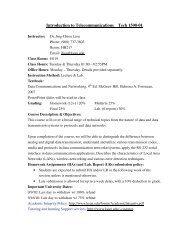Embodying the Sacred in Yoruba Art - Kean University
Embodying the Sacred in Yoruba Art - Kean University
Embodying the Sacred in Yoruba Art - Kean University
You also want an ePaper? Increase the reach of your titles
YUMPU automatically turns print PDFs into web optimized ePapers that Google loves.
gift-bearer (gratitude); and <strong>the</strong> priest hold<strong>in</strong>g a staff (communication<br />
between <strong>the</strong> human and <strong>the</strong> div<strong>in</strong>e). The pr<strong>in</strong>cipal face on most div<strong>in</strong>ation<br />
trays is said to represent Èsù/Elégba, <strong>the</strong> div<strong>in</strong>e messenger who acts as a<br />
scout for <strong>the</strong> div<strong>in</strong>ation deity. 13<br />
Given its ritual and aes<strong>the</strong>tic functions, <strong>the</strong> conta<strong>in</strong>er for stor<strong>in</strong>g sacred<br />
palm nuts for div<strong>in</strong>ation (àgéré Ifá) provides <strong>the</strong> <strong>Yoruba</strong> carver with a unique<br />
opportunity to display his artistic talents. Usually carved from wood and<br />
measur<strong>in</strong>g between five and sixteen <strong>in</strong>ches <strong>in</strong> height, a typical conta<strong>in</strong>er<br />
is <strong>in</strong> <strong>the</strong> form of an animal or human figure bear<strong>in</strong>g a small bowl. In some<br />
cases, <strong>the</strong> metaphysical attribute of a given animal motif (such as a snake<br />
or mudfish) may be used to fur<strong>the</strong>r empower <strong>the</strong> sacred palm nuts <strong>in</strong>side<br />
<strong>the</strong> bowl. But when <strong>the</strong> motif assumes a human form, it frequently has a<br />
votive significance, especially s<strong>in</strong>ce some àgéré Ifá are donated by former<br />
clients. Thus, <strong>the</strong> female weaver motif <strong>in</strong> plate 13 may very well have been<br />
presented to a div<strong>in</strong>er to thank Òrúnmìlà for a bless<strong>in</strong>g or to implore <strong>the</strong><br />
deity to bestow more favors on <strong>the</strong> donor.<br />
The big bowls for enshr<strong>in</strong><strong>in</strong>g palm nuts rarely used for div<strong>in</strong>ation are<br />
called opón ìgèdè. The <strong>in</strong>terior of a typical bowl usually has three or more<br />
compartments, but among <strong>the</strong> Ègbá and Ègbádò <strong>Yoruba</strong>, <strong>the</strong> opón ìgèdè<br />
may be more elaborate. The big rooster motif <strong>in</strong> plate 14 is significant,<br />
given <strong>the</strong> <strong>Yoruba</strong> association of <strong>the</strong> bird with time and vigilance, hence <strong>the</strong><br />
popular say<strong>in</strong>g: “The rooster never forgets to crow at dawn.” 14 Needless<br />
to say, Òrúnmìlà, as a personification of Olódùmaré’s <strong>in</strong>telligence, is ever<br />
ready to help diagnose human problems. Note <strong>the</strong> pedestal for <strong>the</strong> bowl:<br />
<strong>the</strong> figures fac<strong>in</strong>g <strong>the</strong> four card<strong>in</strong>al po<strong>in</strong>ts are rem<strong>in</strong>iscent of Èsù/Elégba,<br />
<strong>the</strong> master of <strong>the</strong> crossroads and a close associate of Òrúnmìlà.<br />
Div<strong>in</strong>ers are recognized <strong>in</strong> public by <strong>the</strong>ir dress, which usually comprises<br />
a white robe (agbádá), an under vest (bùbá or dànsíkí), a pair of long<br />
trousers (sòkòtò), and a cap (fìlà) to match. A str<strong>in</strong>g of yellow and green<br />
beads (otùtù ópón) may be worn on <strong>the</strong> left wrist. Colorful beaded necklaces<br />
called òdìgbà Ifá (checklist 28) are added on ceremonial occasions<br />
or dur<strong>in</strong>g annual festivals when priests from different villages congregate<br />
<strong>in</strong> large towns to celebrate toge<strong>the</strong>r.<br />
Òsanyìn: <strong>the</strong> Deity of Herbal Medic<strong>in</strong>e<br />
Òsanyìn is <strong>the</strong> òrìsà associated with <strong>the</strong> esoteric powers of plants and<br />
<strong>the</strong>ir use to generate àse for pray<strong>in</strong>g, curs<strong>in</strong>g, heal<strong>in</strong>g, or compell<strong>in</strong>g<br />
o<strong>the</strong>rs to obey one’s command. As a result, Òsanyìn is <strong>the</strong> patron deity<br />
of herbalists (onísègùn) and is believed to have <strong>the</strong> capacity to change<br />
<strong>in</strong>to a bird <strong>in</strong> order to commute between heaven and earth. Although <strong>the</strong><br />
deity’s most sacred symbol is a bundle of charms buried <strong>in</strong> <strong>the</strong> ground or<br />
enclosed <strong>in</strong> a calabash, his power can also be localized <strong>in</strong> wrought-iron<br />
17


